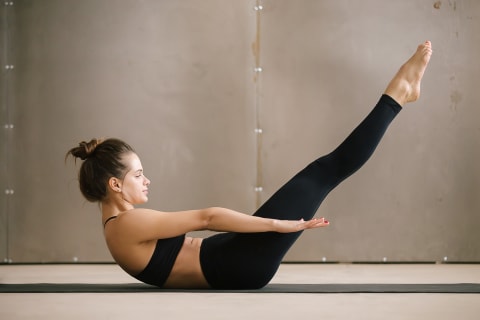So if you’re someone who begrudgingly tacks core work onto the end of your workout, or you only do it when you “feel like it,” this quick circuit might be your soul mate. You’ll spend less time doing this circuit than you would standing in line for the bathroom. (The women’s bathroom. Not the men’s. Don’t even get me started.) “Our core stabilizes our axial skeletal, or our spine and pelvis,” says Sarah Kostyukovsky, DPT. “When our appendages move (our arms and legs), we need to get the stability from our core to efficiently move our body in space. Without a good functioning core, our body is at more risk for injury and our body doesn’t move as effectively, no matter what we do—whether that’s walking, running, lifting, carrying, or exercising in general.” And as Jaime Schehr, N.D., R.D., notes, having a weak core can also lead to back pain (especially lower back pain), which an estimated 80% of adults experience at some point in their lives. Now that we’ve covered the logic, here’s the (expert-approved!) workout: This tends to be one of the more difficult core exercises, but there are several ways to modify it. The first is to keep your arms still in front of you and just alternate lowering each leg from tabletop. Alternatively, you can place your legs in tabletop, crunch up, keeping your arms straight, similar to what you’d do in boat pose, and lower one leg at a time. “It isn’t a good idea to train any body part repeatedly without recovery,” Schehr says. “Doing so can increase your risk of injury. That said, because the core is such a large portion of the body, there are ways to train this area without repeating the same exercise or muscle daily.” Kostyukovsky agrees, adding, “Doing specific core exercises on a daily basis is safe and will make us stronger. If you are doing rectus abdominis and oblique muscle exercises to fatigue and you are sore the next day, I would give those muscles a rest from specific abdominal training. Pelvic floor, diaphragmatic breathing, and deep abdominal muscle exercises can be done daily.” Bottom line: Be consistent about training your core, but vary your exercises to target different sections of your core. And if you’re training your core muscles to the point of intense fatigue and soreness, give yourself a break. Taking a day or two off won’t set you back, and pain is no one’s friend.







